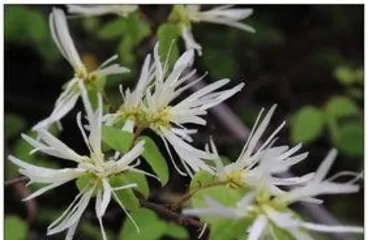Have you ever thought about planting a beautiful white-flowered Loropetalum at your doorstep to add a touch of poetry and tranquility to your life? The name "White-flowered Loropetalum" itself is delightful. It is not only beautiful but also easy to care for. Today, let me give you a detailed introduction on how to grow your White-flowered Loropetalum so that it is lush with branches and covered in flowers!
I. Understanding the White-flowered Loropetalum
The White-flowered Loropetalum, also known as White-flowered Azalea, belongs to the Ericaceae family and is an evergreen shrub or small tree. Its leaves are dark green and glossy, and its flowers are as white as snow, emitting a light fragrance. It is an excellent choice for courtyard landscaping and potted plants.
II. Choosing the Right Planting Location
The White-flowered Loropetalum prefers a sunny environment but can also tolerate shade. Therefore, a semi-shaded location is best for planting. At the same time, ensure the soil has good drainage to avoid waterlogging.
III. Soil Selection and Preparation
The White-flowered Loropetalum is not too demanding on soil, but it is best to choose loose, fertile, and well-drained sandy soil. Before planting, you can add some organic fertilizer, such as well-rotted chicken manure or cow manure, to the soil to increase its fertility.
IV. Planting Time and MethodThe White-flowered Loropetalum is suitable for planting in spring or autumn. When planting, first take the tree out of the pot, gently shake off excess soil from the roots, and then place it in the prepared hole. Note that the planting depth should not be too deep, keeping the root collar level with the ground. When backfilling, gently compact the soil to avoid it being too tight, which would affect root respiration.
V. Watering and FertilizingThe White-flowered Loropetalum likes a moist environment but cannot tolerate waterlogging. When watering, keep the soil moist but not waterlogged. During the hot summer, increase the frequency of watering appropriately. As for fertilizing, spring and autumn are the best times. You can apply compound fertilizer or organic fertilizer once a month.
VI. Pruning and ShapingThe White-flowered Loropetalum grows fast and requires regular pruning to maintain a beautiful shape. When pruning, be sure to cut off diseased, weak, crossing, and inward-growing branches to promote ventilation and light penetration. Additionally, you can shape it according to your personal preferences, such as into a ball or a cone.
VII. Pest and Disease ControlCommon pests and diseases for the White-flowered Loropetalum include aphids and spider mites. When pests or diseases are found, take measures in a timely manner. You can use insecticides for spraying, and at the same time, pay attention to keeping the environment clean to reduce the occurrence of pests and diseases.
VIII. Precautions1. The White-flowered Loropetalum is not cold-tolerant, so pay attention to keeping it warm in winter to avoid frost damage.
2. After planting, regularly check the root growth. If necessary, you can repot it.
3. During the care process, pay attention to the tree's growth condition and adjust the care measures in a timely manner.
The White-flowered Loropetalum is a plant very suitable for home care. As long as you master the correct cultivation methods, I believe you can also have a beautiful White-flowered Loropetalum at your doorstep and enjoy that tranquility and beauty!